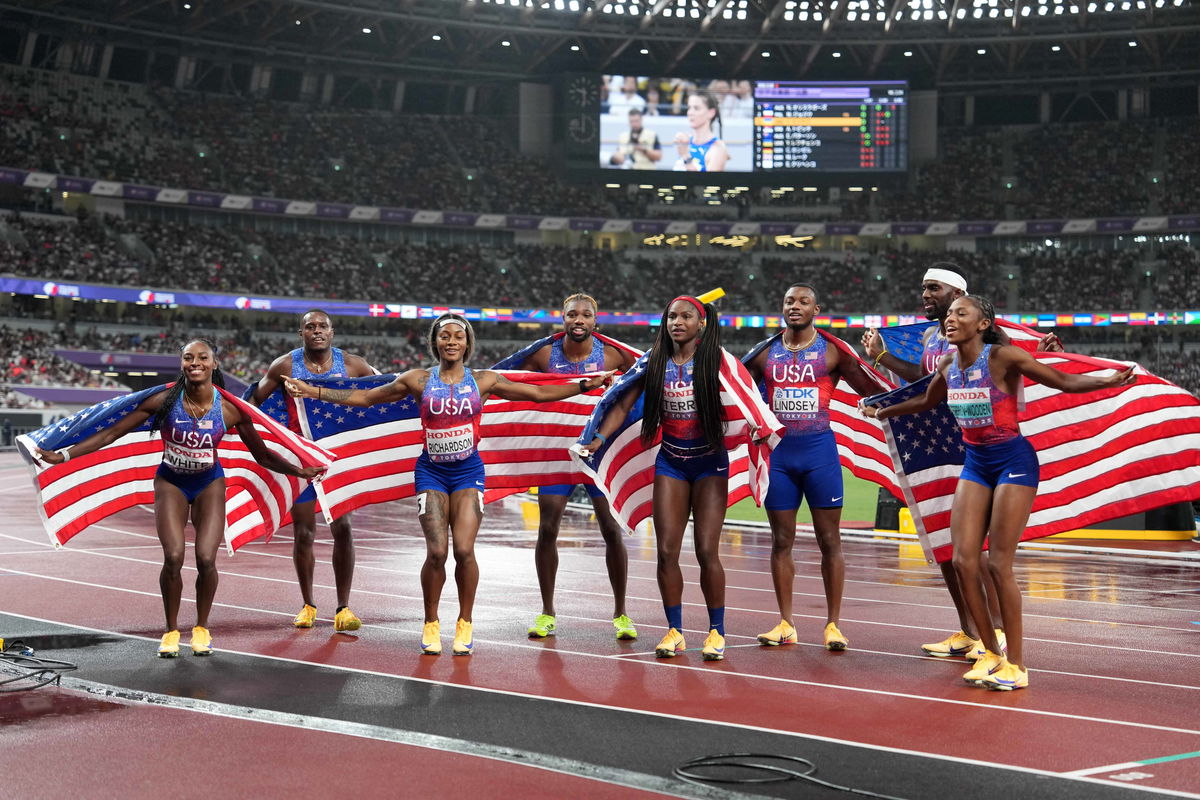
Imago
Track & Field: World Athletics Championships-Evening Session Sep 20, 2025 Tokyo, Japan Members of the United States men s and women s 4 x 100m relay teams pose with gold medals from left Kayla White, Christian Coleman, Sha Carri Richardson, Noah Lyles, Twanisha Terry, Courtney Lindsey, Melissa Jefferson-Wooden and Kenny Bednarek during the World Athletics Championships at National Stadium. Tokyo National Stadium Japan, EDITORIAL USE ONLY PUBLICATIONxINxGERxSUIxAUTxONLY Copyright: xKirbyxLeex 20250922_kdl_al2_006

Imago
Track & Field: World Athletics Championships-Evening Session Sep 20, 2025 Tokyo, Japan Members of the United States men s and women s 4 x 100m relay teams pose with gold medals from left Kayla White, Christian Coleman, Sha Carri Richardson, Noah Lyles, Twanisha Terry, Courtney Lindsey, Melissa Jefferson-Wooden and Kenny Bednarek during the World Athletics Championships at National Stadium. Tokyo National Stadium Japan, EDITORIAL USE ONLY PUBLICATIONxINxGERxSUIxAUTxONLY Copyright: xKirbyxLeex 20250922_kdl_al2_006
The USA Track and Field announced its newest financial update, marking a shift in the tides. The federation has been operating with a confidence that it hasn’t displayed in years. The clues signalling this change in demeanor point to a broader shift in stability, ambition, and long-term planning. With the emergence of new revenue streams, the USATF might just be looking at a breakthrough in finances. The reason: the $8M surge in its audited revenue for 2024, caused by the growing fame of athletes like Sydney McLaughlin-Levrone, Noah Lyles, etc.
Watch What’s Trending Now!
The numbers clearly signal the momentum shift. According to USATF’s report, the audited revenue for 2024 went up to an all-time high of $44.6 million. And that’s about $8 million more than the revenue in 2023. What caused the surge? That credit goes to stronger sponsorships, rising membership fees, successful events, and an increase in the sale of merchandise throughout the world. Remember the deficit of $5.48M in 2023? Two years down the road, the USATF claims that there might be an operating surplus in the revenue for 2025 – remember the recently announced 2026 USATF Tour?
The cause of the broadcast surge stems from rising athlete popularity. NCAA gymnasts have become the most marketable college athletes in the country, driving massive social engagement, viral routines, and record-setting attendance. Stars like Sydney McLaughlin-Levrone, Noah Lyles, and Kenny Bednarek turned the sport into a mainstream entertainment product with their accolades and bustling rivalry that keeps fans hooked to USATF events. This growing fandom reeled in sponsors, apparel companies, and national advertisers. It even signals the possibility of the LA Grand Prix in 2026.
ADVERTISEMENT
With increasing sponsorship money and NIL opportunities, networks merged themselves with the trend through expanded coverage to capture the rising commercial value created largely by the athletes’ influence and online visibility. In the press release by the USATF, as reported by Citius Mag on X, the key expenditures included $10.5 million on sports performance, $15 million on elite athletic competitions, and more than $10 million on final investments related to the 2022 World Championships.
🇺🇸 USA Track & Field reported an all-time high $44.6 million in audited revenue for 2024, up nearly $8 million from 2023. Revenue growth reportedly came from sponsorships, membership fees, event income and merchandise sales.
USATF reduced its deficit from $5.48M in 2023 to… pic.twitter.com/TlLH8CucmL
— CITIUS MAG (@CitiusMag) November 17, 2025
Additionally, the salary costs increased from $9.2M to $10.54M. Travel and business meals totalled $9.99M. Each year, from the $20M sponsorship revenue, $975,000 is paid as commission, and this will go on until the contract with Nike expires in 2040. Furthermore, from 2025, the federation will receive $14.15M from the transfer of Paralympic track and field under its wing.
ADVERTISEMENT
But the financial rebound isn’t just about numbers on a balance sheet. It also raises questions about what went wrong the year before. Beneath the optimism of 2024’s surge lies the sharp contrast of 2023, a year that forced USATF into tough decisions, strategic risks, and recalibrated priorities. And that’s where the story becomes even more compelling.
ADVERTISEMENT
USATF spokesperson weighs in on the revenue shortfall in 2023
As per the USATF spokesperson, Aarti Parekh, the shortfall in the revenue was because of “board-approved investments.” In her email to Runner’s World, she wrote, “As outlined in our audited financials, 2023 was a pivotal year in USATF’s quadrennial journey to the 2024 Olympic Games. So, these strategic expenditures reflect USATF’s commitment to athlete readiness on the world stage and delivering historic on-field success at all levels, including a record-breaking showing in Paris.”
That year, the CEO, Max Siegel, took home only $1.17 million. It was a steep fall of $1.26M from 2022. That’s a shocking fall, considering he had a salary of $3.86 million in 2021. Well, the marketing took a heavy fall in 2023. The sponsorships and royalties accumulated only $19.2M. That was lower than that in the COVID-19 pandemic year. But we can’t really compare the revenue with the pandemic period. Why? Because a few sponsors adjusted their agreements, and that impacted the revenue streams. Parekh additionally wrote, “USATF recognizes revenue differently based on the timing of when it is earned versus when it is received, which can create fluctuations in year-to-year comparisons.”
Nevertheless, in November 2023, Max Siegel signed a five-year contract extension with the USATF. And that decision helped the federation to create a strong revenue base, providing around $6.8M for athlete support and development. And despite the turbulence of 2023, USATF’s renewed stability and long-term strategy suggest a federation rebuilding its foundation with purpose. With stronger revenues ahead and key leadership secured, the organization now appears positioned for a far more controlled, confident path forward.
ADVERTISEMENT
ADVERTISEMENT
ADVERTISEMENT
ADVERTISEMENT

